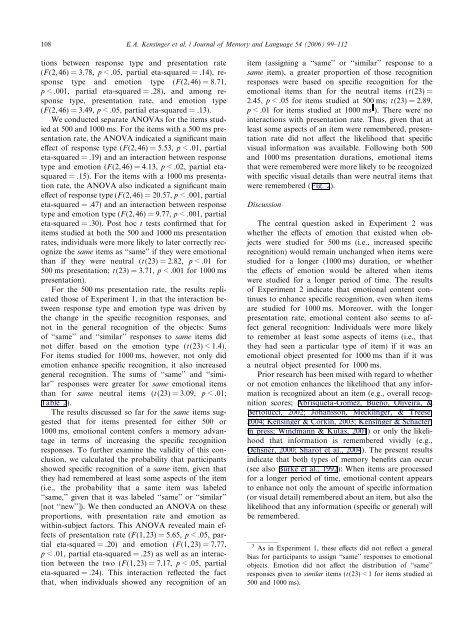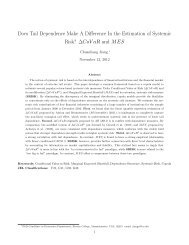Memory for specific visual details can be enhanced by negative ...
Memory for specific visual details can be enhanced by negative ...
Memory for specific visual details can be enhanced by negative ...
Create successful ePaper yourself
Turn your PDF publications into a flip-book with our unique Google optimized e-Paper software.
108 E.A. Kensinger et al. / Journal of <strong>Memory</strong> and Language 54 (2006) 99–112<br />
tions <strong>be</strong>tween response type and presentation rate<br />
(F(2,46) = 3.78, p < .05, partial eta-squared = .14), response<br />
type and emotion type (F(2,46) = 8.71,<br />
p < .001, partial eta-squared = .28), and among response<br />
type, presentation rate, and emotion type<br />
(F(2,46) = 3.49, p < .05, partial eta-squared = .13).<br />
We conducted separate ANOVAs <strong>for</strong> the items studied<br />
at 500 and 1000 ms. For the items with a 500 ms presentation<br />
rate, the ANOVA indicated a signifi<strong>can</strong>t main<br />
effect of response type (F(2,46) = 5.53, p < .01, partial<br />
eta-squared = .19) and an interaction <strong>be</strong>tween response<br />
type and emotion (F(2,46) = 4.13, p < .02, partial etasquared<br />
= .15). For the items with a 1000 ms presentation<br />
rate, the ANOVA also indicated a signifi<strong>can</strong>t main<br />
effect of response type (F(2,46) = 20.57, p < .001, partial<br />
eta-squared = .47) and an interaction <strong>be</strong>tween response<br />
type and emotion type (F(2,46) = 9.77, p < .001, partial<br />
eta-squared = .30). Post hoc t tests confirmed that <strong>for</strong><br />
items studied at both the 500 and 1000 ms presentation<br />
rates, individuals were more likely to later correctly recognize<br />
the same items as ‘‘same’’ if they were emotional<br />
than if they were neutral (t(23) = 2.82, p < .01 <strong>for</strong><br />
500 ms presentation; t(23) = 3.71, p < .001 <strong>for</strong> 1000 ms<br />
presentation).<br />
For the 500 ms presentation rate, the results replicated<br />
those of Experiment 1, in that the interaction <strong>be</strong>tween<br />
response type and emotion type was driven <strong>by</strong><br />
the change in the <strong>specific</strong> recognition responses, and<br />
not in the general recognition of the objects: Sums<br />
of ‘‘same’’ and ‘‘similar’’ responses to same items did<br />
not differ based on the emotion type (t(23) < 1.4).<br />
For items studied <strong>for</strong> 1000 ms, however, not only did<br />
emotion enhance <strong>specific</strong> recognition, it also increased<br />
general recognition. The sums of ‘‘same’’ and ‘‘similar’’<br />
responses were greater <strong>for</strong> same emotional items<br />
than <strong>for</strong> same neutral items (t(23) = 3.09, p < .01;<br />
Table 2).<br />
The results discussed so far <strong>for</strong> the same items suggested<br />
that <strong>for</strong> items presented <strong>for</strong> either 500 or<br />
1000 ms, emotional content confers a memory advantage<br />
in terms of increasing the <strong>specific</strong> recognition<br />
responses. To further examine the validity of this conclusion,<br />
we calculated the probability that participants<br />
showed <strong>specific</strong> recognition of a same item, given that<br />
they had remem<strong>be</strong>red at least some aspects of the item<br />
(i.e., the probability that a same item was la<strong>be</strong>led<br />
‘‘same,’’ given that it was la<strong>be</strong>led ‘‘same’’ or ‘‘similar’’<br />
[not ‘‘new’’]). We then conducted an ANOVA on these<br />
proportions, with presentation rate and emotion as<br />
within-subject factors. This ANOVA revealed main effects<br />
of presentation rate (F(1,23) = 5.65, p < .05, partial<br />
eta-squared = .20) and emotion (F(1,23) = 7.77,<br />
p < .01, partial eta-squared = .25) as well as an interaction<br />
<strong>be</strong>tween the two (F(1,23) = 7.17, p < .05, partial<br />
eta-squared = .24). This interaction reflected the fact<br />
that, when individuals showed any recognition of an<br />
item (assigning a ‘‘same’’ or ‘‘similar’’ response to a<br />
same item), a greater proportion of those recognition<br />
responses were based on <strong>specific</strong> recognition <strong>for</strong> the<br />
emotional items than <strong>for</strong> the neutral items (t(23) =<br />
2.45, p < .05 <strong>for</strong> items studied at 500 ms; t(23) = 2.89,<br />
p < .01 <strong>for</strong> items studied at 1000 ms 3 ). There were no<br />
interactions with presentation rate. Thus, given that at<br />
least some aspects of an item were remem<strong>be</strong>red, presentation<br />
rate did not affect the likelihood that <strong>specific</strong><br />
<strong>visual</strong> in<strong>for</strong>mation was available. Following both 500<br />
and 1000 ms presentation durations, emotional items<br />
that were remem<strong>be</strong>red were more likely to <strong>be</strong> recognized<br />
with <strong>specific</strong> <strong>visual</strong> <strong>details</strong> than were neutral items that<br />
were remem<strong>be</strong>red (Fig. 2).<br />
Discussion<br />
The central question asked in Experiment 2 was<br />
whether the effects of emotion that existed when objects<br />
were studied <strong>for</strong> 500 ms (i.e., increased <strong>specific</strong><br />
recognition) would remain unchanged when items were<br />
studied <strong>for</strong> a longer (1000 ms) duration, or whether<br />
the effects of emotion would <strong>be</strong> altered when items<br />
were studied <strong>for</strong> a longer period of time. The results<br />
of Experiment 2 indicate that emotional content continues<br />
to enhance <strong>specific</strong> recognition, even when items<br />
are studied <strong>for</strong> 1000 ms. Moreover, with the longer<br />
presentation rate, emotional content also seems to affect<br />
general recognition: Individuals were more likely<br />
to remem<strong>be</strong>r at least some aspects of items (i.e., that<br />
they had seen a particular type of item) if it was an<br />
emotional object presented <strong>for</strong> 1000 ms than if it was<br />
a neutral object presented <strong>for</strong> 1000 ms.<br />
Prior research has <strong>be</strong>en mixed with regard to whether<br />
or not emotion enhances the likelihood that any in<strong>for</strong>mation<br />
is recognized about an item (e.g., overall recognition<br />
scores; Abrisqueta-Gomez, Bueno, Oliveira, &<br />
Bertolucci, 2002; Johansson, Mecklinger, & Treese,<br />
2004; Kensinger & Corkin, 2003; Kensinger & Schacter,<br />
in press; Windmann & Kutas, 2001) or only the likelihood<br />
that in<strong>for</strong>mation is remem<strong>be</strong>red vividly (e.g.,<br />
Ochsner, 2000; Sharot et al., 2004). The present results<br />
indicate that both types of memory <strong>be</strong>nefits <strong>can</strong> occur<br />
(see also Burke et al., 1992): When items are processed<br />
<strong>for</strong> a longer period of time, emotional content appears<br />
to enhance not only the amount of <strong>specific</strong> in<strong>for</strong>mation<br />
(or <strong>visual</strong> detail) remem<strong>be</strong>red about an item, but also the<br />
likelihood that any in<strong>for</strong>mation (<strong>specific</strong> or general) will<br />
<strong>be</strong> remem<strong>be</strong>red.<br />
3 As in Experiment 1, these effects did not reflect a general<br />
bias <strong>for</strong> participants to assign ‘‘same’’ responses to emotional<br />
objects. Emotion did not affect the distribution of ‘‘same’’<br />
responses given to similar items (t(23) < 1 <strong>for</strong> items studied at<br />
500 and 1000 ms).

















